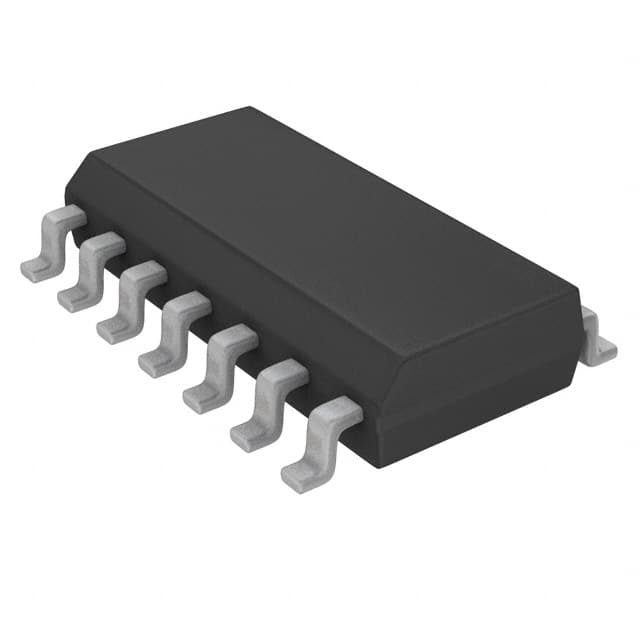PIC16F506-I/SL
Product Overview
Category
The PIC16F506-I/SL belongs to the category of microcontrollers.
Use
This microcontroller is commonly used in various electronic devices and embedded systems for controlling and processing data.
Characteristics
- Low-power consumption
- High-performance RISC CPU
- Flash program memory
- EEPROM data memory
- Analog-to-digital converter (ADC)
- Timers and counters
- Serial communication interfaces
- Wide operating voltage range
Package
The PIC16F506-I/SL is available in a small outline integrated circuit (SOIC) package.
Essence
The essence of this microcontroller lies in its ability to provide efficient control and processing capabilities in a compact and low-power package.
Packaging/Quantity
The PIC16F506-I/SL is typically packaged in reels or tubes, with a quantity of 250 units per reel/tube.
Specifications
- CPU: 8-bit RISC
- Program Memory: 1.75 KB Flash
- Data Memory: 64 bytes EEPROM
- Operating Voltage Range: 2.0V to 5.5V
- ADC Resolution: 10-bit
- Timers: 1 x 8-bit, 1 x 16-bit
- Communication Interfaces: SPI, I2C, UART
Detailed Pin Configuration
The PIC16F506-I/SL has a total of 14 pins, each serving a specific purpose. The pin configuration is as follows:
- VDD - Power supply voltage
- RA0/AN0 - Analog input or digital I/O
- RA1/AN1 - Analog input or digital I/O
- RA2/AN2 - Analog input or digital I/O
- RA3/AN3 - Analog input or digital I/O
- RA4/T0CKI - Timer0 clock input or digital I/O
- RA5/AN4 - Analog input or digital I/O
- MCLR/VPP - Master Clear input or programming voltage
- VSS - Ground
- RB0/INT - External interrupt or digital I/O
- RB1/SDI/SDA - Serial data input or I2C data or digital I/O
- RB2/SDO/SCL - Serial data output or I2C clock or digital I/O
- RB3/PGM - Programming voltage or digital I/O
- RB4/PGC - Programming clock or digital I/O
Functional Features
- Low-power operation for energy-efficient applications
- High-performance RISC CPU for fast and efficient processing
- Flash program memory for easy reprogramming of the microcontroller
- EEPROM data memory for storing non-volatile data
- Analog-to-digital converter (ADC) for precise analog measurements
- Timers and counters for accurate timing and event counting
- Serial communication interfaces (SPI, I2C, UART) for data exchange with other devices
Advantages and Disadvantages
Advantages
- Compact size and low-power consumption make it suitable for portable and battery-powered devices.
- Versatile functionality enables a wide range of applications.
- Easy to program and reprogram using standard development tools.
- Cost-effective solution for many embedded system designs.
Disadvantages
- Limited program memory and data memory compared to higher-end microcontrollers.
- Less processing power compared to 16-bit or 32-bit microcontrollers.
- May require additional external components for certain applications.
Working Principles
The PIC16F506-I/SL operates based on the principles of a RISC (Reduced Instruction Set Computer) architecture. It executes instructions stored in its program memory to perform various tasks. The microcontroller interacts with external devices through its input/output pins, utilizing its built-in peripherals such as timers, ADC, and communication interfaces.
Detailed Application Field Plans
The PIC16F506-I/SL finds applications in various fields, including but not limited to: - Home automation systems - Industrial control systems - Consumer electronics - Automotive electronics - Medical devices - Internet of Things (IoT) devices
Detailed and Complete Alternative Models
Some alternative models that offer similar functionality to the PIC16F506-I/SL include: - PIC16F505-I/SL - PIC16F507-I/SL - PIC16F508-I/SL - PIC16F509-I/SL
These alternative models provide different memory sizes, additional features, or variations in pin configuration to cater to specific application requirements.
In conclusion, the PIC16F506-I/SL is a versatile microcontroller offering low-power operation, high-performance processing, and various built-in peripherals. Its compact size and cost-effectiveness make it suitable for a wide range of applications in different industries.
Lista 10 Vanliga frågor och svar relaterade till tillämpningen av PIC16F506-I/SL i tekniska lösningar
What is the maximum operating frequency of PIC16F506-I/SL?
- The maximum operating frequency of PIC16F506-I/SL is 20 MHz.Can PIC16F506-I/SL be used in battery-powered applications?
- Yes, PIC16F506-I/SL is suitable for battery-powered applications due to its low power consumption.What are the available communication interfaces on PIC16F506-I/SL?
- PIC16F506-I/SL supports SPI and I2C communication interfaces.Is it possible to program PIC16F506-I/SL using a high-level language like C?
- Yes, PIC16F506-I/SL can be programmed using high-level languages such as C.What are the available memory options for program storage in PIC16F506-I/SL?
- PIC16F506-I/SL offers flash program memory with options ranging from 1.75 KB to 3.5 KB.Can PIC16F506-I/SL be used in temperature-sensitive applications?
- Yes, PIC16F506-I/SL has a wide operating temperature range, making it suitable for temperature-sensitive applications.Does PIC16F506-I/SL have built-in analog-to-digital conversion (ADC) capability?
- Yes, PIC16F506-I/SL features an integrated 10-bit ADC for analog signal processing.What are the available package options for PIC16F506-I/SL?
- PIC16F506-I/SL is available in various package options including SOIC and PDIP.Is there a development kit available for PIC16F506-I/SL?
- Yes, Microchip provides a development kit specifically designed for PIC16F506-I/SL.Can PIC16F506-I/SL be used in automotive applications?
- Yes, PIC16F506-I/SL is suitable for automotive applications as it meets the necessary industry standards and requirements.


